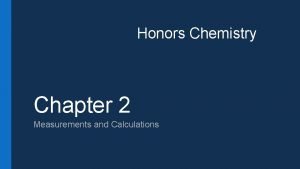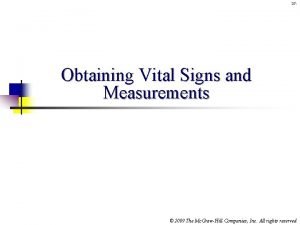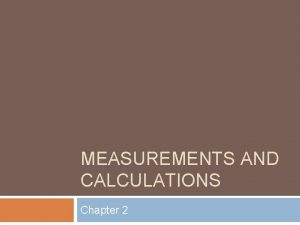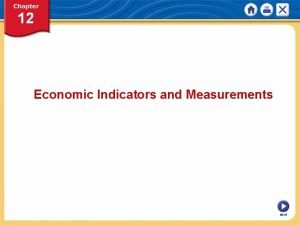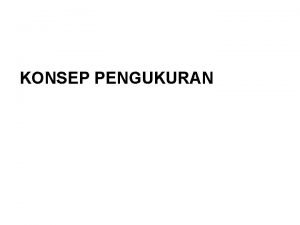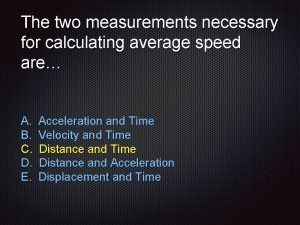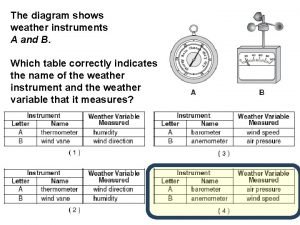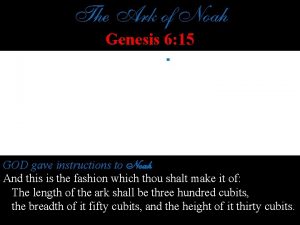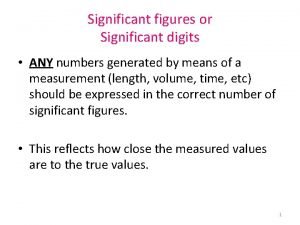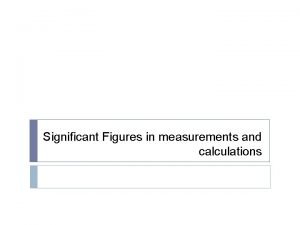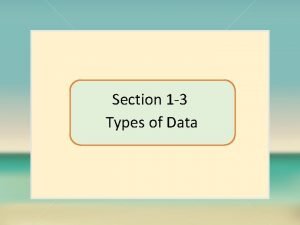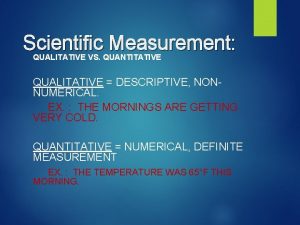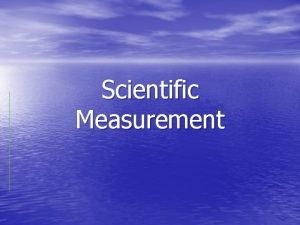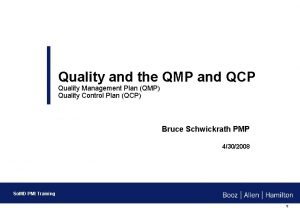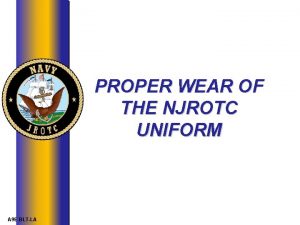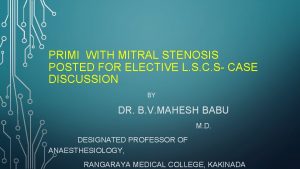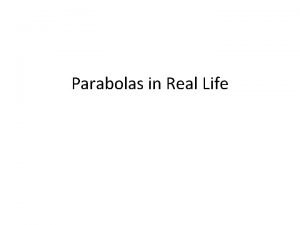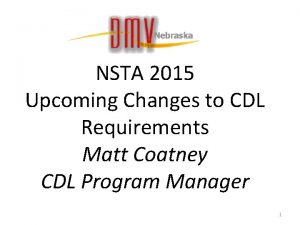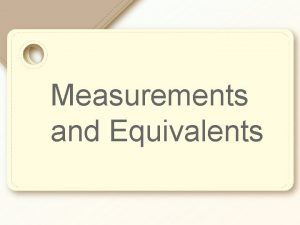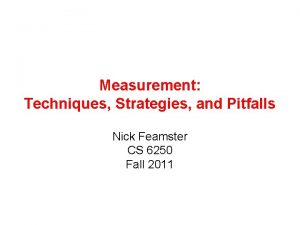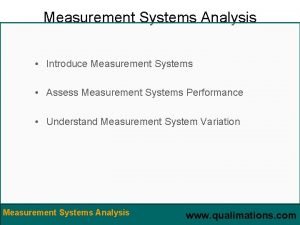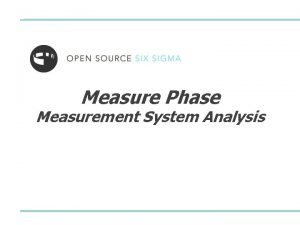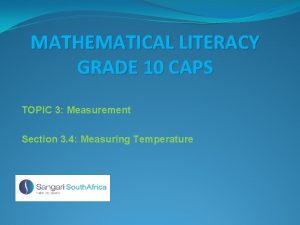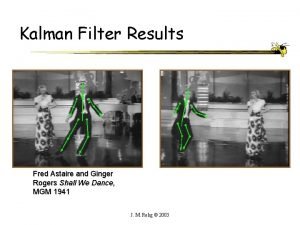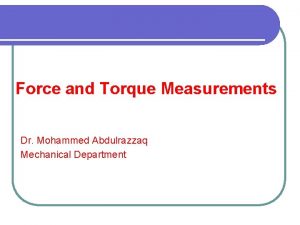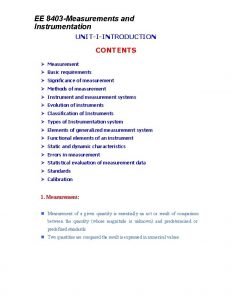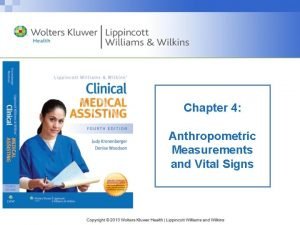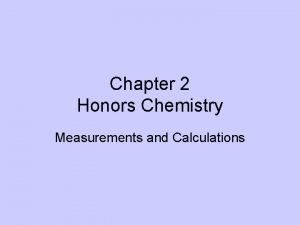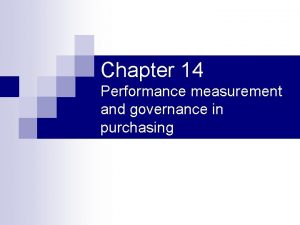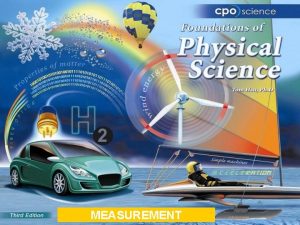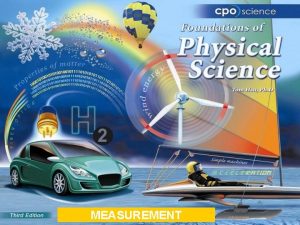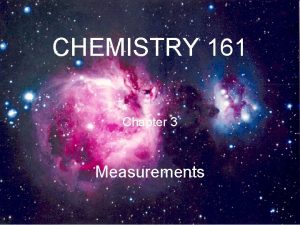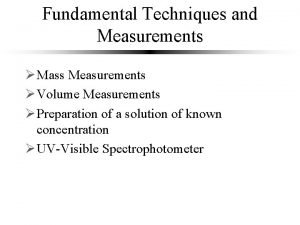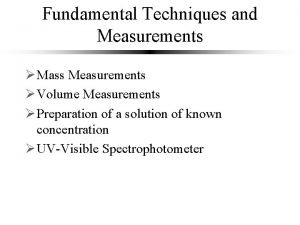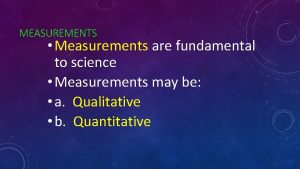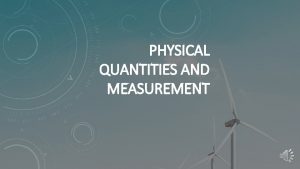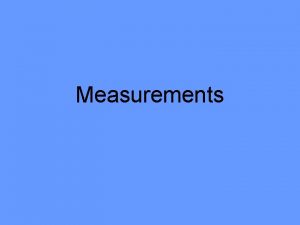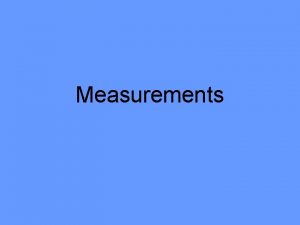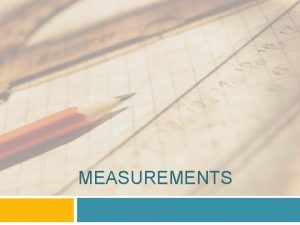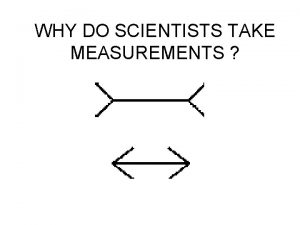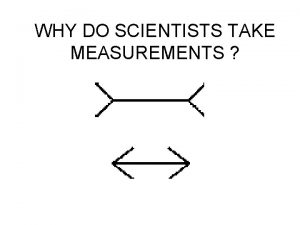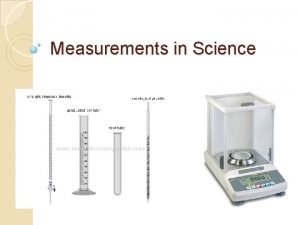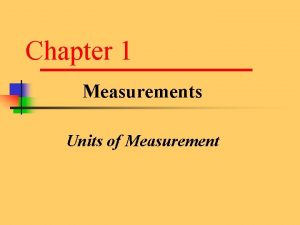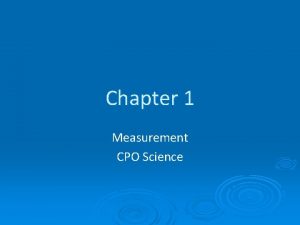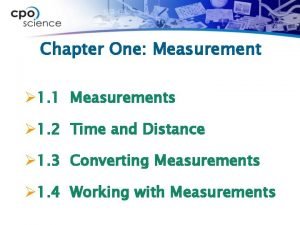MEASUREMENT Chapter One Measurement 1 1 Measurements 1












































- Slides: 44

MEASUREMENT

Chapter One: Measurement Ø 1. 1 Measurements Ø 1. 2 Time and Distance Ø 1. 3 Converting Measurements Ø 1. 4 Working with Measurements

Section 1. 1 Learning Goals ØDefine measurement. ØCompare English and SI measurements. ØBecome familiar with metric prefixes.

Investigation 1 A Measurement ØKey Question: Are you able to use scientific tools to make accurate measurements?

1. 1 Measurements ØA measurement is a determination of the amount of something. ØA measurement has two parts: Ø a number value and Ø a unit

1. 1 Two common systems ØThe English System is used for everyday measurements in the United States. ØMiles, yards, feet, inches, pounds, pints, quarts, gallons, cups, and teaspoons are all English system units. ØIn 1960, the Metric System was revised and simplified, and a new name was adopted— International System of Units.

1. 1 International System of Measurement (SI) ØThe acronym SI comes from the French name Le Système International d’Unités. ØSI units form a base-10 or decimal system. ØIn the metric system, there are: Ø 10 millimeters in a centimeter, Ø 100 centimeters in a meter, and Ø 1, 000 meters in a kilometer.

1. 1 The meter stick ØA meter stick is 1 meter long and is divided into millimeters and centimeters.

1. 1 The meter stick ØEach centimeter is divided into ten smaller units, called millimeters. What is the length in cm?


Chapter One: Measurement Ø 1. 1 Measurements Ø 1. 2 Time and Distance Ø 1. 3 Converting Measurements Ø 1. 4 Working with Measurements

Section 1. 2 Learning Goals ØExplain the meaning of time in a scientific sense. ØDiscuss how distance is measured. ØUse a metric ruler to measure distance.

1. 2 Time and Distance ØTwo ways to think about time: Ø What time is it? Ø How much time? ØA quantity of time is also called a time interval.

1. 2 Time ØTime comes in mixed units. Ø Seconds are very short. Ø For calculations, you may need to convert hours and minutes into seconds. How many seconds is this time interval?

1. 2 Distance Ø Distance is the amount of space between two points. Ø Distance is measured in units of length. Ø The meter is a basic SI distance unit. In 1791, a meter was defined as one ten-millionth of the distance from the North Pole to the equator. What standard is used today?

1. 2 Metric prefixes Ø Prefixes are added to the names of basic SI units such as meter, liter and gram. Ø Prefixes describe very small or large measurements.



Chapter One: Measurement Ø 1. 1 Measurements Ø 1. 2 Time and Distance Ø 1. 3 Converting Measurements Ø 1. 4 Working with Measurements

Section 1. 3 Learning Goals ØWrite conversion factors. ØApply the decimal point rule to convert between metric quantities. ØUse dimensional analysis to convert English and SI measurements.

1. 3 Converting units ØTo convert 1, 565 pennies to the dollar amount, you divide 1, 565 by 100 (since there are 100 pennies in a dollar). ØConverting SI units is just as easy as converting pennies to dollars.

Solving Problems Ø Convert 655 mm to m 1. Looking for: Ø …the distance in meters 2. Given: Ø …distance = 655 millimeters 3. Relationships: Ø Ex. There are 1000 millimeters in 1 meter 4. Solution: 655 mm =. 655 meters

Solving Problems Convert 142 km to m 1. Looking for: Ø …the distance in meters 2. Given: Ø …distance = 142 kilometers 3. Relationships: Ø Ex. There are ? meters in 1 kilometer? 4. Solution: Ø Use the conversion tool.

Solving Problems Convert 754, 000 cm to km 1. Looking for: Ø …the distance in kilometers 2. Given: Ø …distance = 754, 000 centimeters 3. Relationships: Ø Ex. There are ? cm in 1 m? Ø There are ? m in 1 km? 4. Solution: Ø Use the conversion tool.

1. 3 Converting units Ø A conversion factor is a ratio that has the value of one. Ø This method of converting units is called dimensional analysis. Ø To do the conversion you multiply 4. 5 feet by a conversion factor.

Solving Problems Convert 4. 5 ft to cm 1. Looking for: Ø You are asked for the distance in cm 2. Given: Ø You are given the distance in ft. 3. Relationships: Ø Ex. There are ? cm in 1 ft? 30. 48 cm = 1 ft 4. Solution: Ø Make a conversion factor from equivalent

1. 3 Converting units Ø Use the correct conversion factor to convert: Ø 175 yds. to m. Ø 2. 50 in. to mm.


Chapter One: Measurement Ø 1. 1 Measurements Ø 1. 2 Time and Distance Ø 1. 3 Converting Measurements Ø 1. 4 Working with Measurements

Section 1. 4 Learning Goals ØDetermine the number of significant figures in measurements. ØDistinguish accuracy, precision, and resolution. ØCompare data sets to determine if they are significantly different.

Investigation 1 B Conversion Chains ØKey Question: How can you use unit canceling to solve conversion problems?

1. 4 Working with Measurements Ø Accuracy is how close a measurement is to the accepted, true value. Ø Precision describes how close together repeated measurements or events are to one another.

1. 4 Working with Measurements Ø In the real world it is impossible for everyone to arrive at the exact same true measurement as everyone else. Find the length of the object in centimeters. How many digits does your answer have?

1. 4 Working with Measurements Digits that are always significant: 1. Non-zero digits. 2. Zeroes between two significant digits. 3. All final zeroes to the right of a decimal point. Digits that are never significant: 4. Leading zeroes to the right of a decimal point. (0. 002 cm has only one significant digit. ) 5. Final zeroes in a number that does not have a decimal point.

Solving Problems What is area of 8. 5 in. x 11. 0 in. paper? 1. Looking for: Ø …area of the paper 2. Given: Ø … width = 8. 5 in; length = 11. 0 in 3. Relationship: Ø Area = W x L 4. Solution: Ø 8. 5 in x 11. 0 in = 93. 5 in 2 # Sig. fig = 94 in 2

1. 4 Working with Measurements Ø Using the bow and arrow analogy explain how it is possible to be precise but inaccurate with a stopwatch, ruler or other tool.

1. 4 Resolution Ø Resolution refers to the smallest interval that can be measured. Ø You can think of resolution as the “sharpness” of a measurement.


1. 4 Significant differences Ø In everyday conversation, “same” means two numbers that are the same exactly, like 2. 56 and 2. 56. Ø When comparing scientific results “same” means “not significantly different”. Ø Significant differences are differences that are MUCH larger than the estimated error in the results.

1. 4 Error and significance Ø How can you tell if two results are the same when both contain error (uncertainty)? Ø When we estimate error in a data set, we will assume the average is the exact value. Ø If the difference in the averages is at least three times larger than the average error, we say the difference is “significant”.

1. 4 Error Ø How you can you tell if two results are the same when both contain error. ØCalculate error ØAverage error ØCompare average error

Solving Problems Is there a significant difference in data? 1. Looking for: Ø Significant difference between two data sets 2. Given: Ø Table of data 3. Relationships: Ø Estimate error, Average error, 3 X average error 4. Solution: Ø Math answer: 93. 5 in 2 Ø Determine # of significant figures = 94 in 2

Investigation 1 C Significant Digits ØKey Question: How do we make precise measurements?

Nanotechnology ØWhat if biological nanomachines could seek out a broken part of a cell and fix it? How can a nanomachine mimic nature’s ability to heal? ØThese are the cutting-edge questions that nanomedicine scientists are trying to answer.
 Chapter 2 measurements and calculations
Chapter 2 measurements and calculations Sign chapter 37
Sign chapter 37 Orthostatic vital signs
Orthostatic vital signs Measurements and calculations chapter 2 test
Measurements and calculations chapter 2 test Gdp types
Gdp types One god one empire one emperor
One god one empire one emperor Little dog run
Little dog run One king one law one faith
One king one law one faith Byzantine definition
Byzantine definition One ford plan
One ford plan See one do one teach one
See one do one teach one One price policy
One price policy Night structure
Night structure See one do one teach one
See one do one teach one Asean tourism strategic plan
Asean tourism strategic plan One vision one identity one community
One vision one identity one community One dimensional measurement
One dimensional measurement How big is 5cm
How big is 5cm What two measurements are necessary for calculating speed
What two measurements are necessary for calculating speed Which diagram shows surface weather measurements?
Which diagram shows surface weather measurements? Noah's ark measurements
Noah's ark measurements Significant figures rules
Significant figures rules Unlimited significant figures
Unlimited significant figures It consists of numbers representing counts or measurements.
It consists of numbers representing counts or measurements. Qualitative vs quantitative science
Qualitative vs quantitative science Scientific measurements
Scientific measurements Hip er rom
Hip er rom What is qmp
What is qmp Njrotc sdb
Njrotc sdb Wilkins score
Wilkins score Posterior palatal seal classification
Posterior palatal seal classification Parabola graph in real life
Parabola graph in real life Cdl parallel parking measurements
Cdl parallel parking measurements Measurements equivalents and adjustments
Measurements equivalents and adjustments Cs6250 bgp measurements
Cs6250 bgp measurements Measurements system analysis
Measurements system analysis Attribute repeatability and reproducibility
Attribute repeatability and reproducibility Mathematical literacy grade 10 measurements
Mathematical literacy grade 10 measurements How to measure triple jump
How to measure triple jump Ginger rogers measurements
Ginger rogers measurements Force and torque measurements
Force and torque measurements Ee8403 measurements and instrumentation
Ee8403 measurements and instrumentation Anthropometric measurement includes vital signs
Anthropometric measurement includes vital signs Measurements in chemistry
Measurements in chemistry Purchasing goals measurements
Purchasing goals measurements
